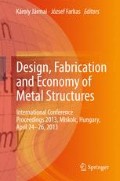Abstract
Optimization techniques have been used extensively over the last decades to assist in the design of steel structures. This paper describes the integrated use of a number of these techniques in the costing and design of a large-scale housing for a Vertical Axis Wind Turbine (VAWT) satisfying British Standards. The problem is complex with seven different wind loadings applied to an atypical geometry and as many as 1400 design variables. The housing is subject to displacement, stress and buckling constraints on each component. Ease of transportation and manufacturability are also considered in the design.
The aerodynamic outer surface of the housing was predetermined and computational fluid dynamic modelling was used to determine the pressure loads on the housing under different orientations. An initial topological optimisation identified a suitable construction method for the design. These results indicated a space frame approach. A steel framework of circular hollow sections was established based on the results of the optimization. Continuous gradient-based size optimization using global search methods was carried out on each of the structural members. A discrete size optimization followed to enable the structure to be built from a small number of standard sections. The final design was tested to ensure conformity with British Standard BS 5950: 1-2000.
Designs were obtained for 11 different sized structures all conforming to the British Standards. The housings were split into sub-divisions suitable for transportation by road or rail. Each housing was constructed using no more than 12 standard sized sections. The study has provided weight data for assessing the most appropriate structure for future industrial development including aspects of manufacture and cost. A suitable step-wise method has been developed for solving large-scale optimization problems with both large numbers of design variables and constraints.
Access this chapter
Tax calculation will be finalised at checkout
Purchases are for personal use only
Preview
Unable to display preview. Download preview PDF.
References
Altair Hyperworks. OptiStruct 11.0 User Guide (2011), http://www.altairhyperworks.co.uk/ (accessed September 1, 2011)
Bendsøe, M.P.: Optimal shape design as a material distribution problem. Structural and Multidisciplinary Optimization 1(4), 193–202 (1989)
British Standard, Structural Use of Steelwork in Building. Part 1: Code of practice for design of rolled and welded sections. BS 5950-1: 2000 (2000)
C-fec. (2012), http://www.c-fec.com/ (accessed September 1, 2011)
Croft, T.N., Carswell, D., et al.: Parallel Computational Fluid Dynamics - not without its challenges. In: 1st International Conference on Parallel Distributed and Grid Computing for Engineering, Pecs, Hungary. Civil-Comp Press, Stirlingshire (2009)
Croft, T.N., Pericleous, K., et al.: PHYSICA: A Multiphysics Environment for Complex Flow Processes. Numerical Methods in Laminar and Turbulent Flow IX, 1269–1280 (1995)
Frontline Solvers Inc. Frontline Solvers - User Guide - Version 11.5 (2012), http://www.solver.com/ (accessed June 1, 2012)
Patankar, S.V., Spalding, D.B.: A Calculation Procedure for Heat, Mass and Momentum Transfer in Three-Dimensional Parabolic Flows. International Journal of Heat and Mass Transfer 15, 1787–1906 (1972)
Rhie, C.M., Chow, W.L.: Numerical Study of the Turbulent Flow Past an Airfoil with Trailing Edge Separation. AIAA Journal, 1525–1532 (1983)
Rolland, S., Williams, A.J.: CFD Modelling of Fluid Flow through Rotating Machinery. In: 17th UK Conference on Computational Mechanics (ACME-UK), Nottingham, UK (2009)
Rozvany, G.I.N., Zhou, M., et al.: Generalized shape optimization without homogenization. Structural and Multidisciplinary Optimization 4(3), 250–252 (1992)
Van Doormal, J.P., Raithby, G.D.: Enhancement of the SIMPLE Method for Predicting Incompressible Fluid Flow. Numerical Heat Transfer 7, 147–163 (1984)
Author information
Authors and Affiliations
Corresponding author
Editor information
Editors and Affiliations
Rights and permissions
Copyright information
© 2013 Springer-Verlag Berlin Heidelberg
About this paper
Cite this paper
Morgan, H.D., Rolland, S.A., Sienz, J., Gil, A.J., Bould, D.C., Ellis, R. (2013). Design and Optimization of a Vertical Axis Wind Turbine Housing to Standards. In: Jármai, K., Farkas, J. (eds) Design, Fabrication and Economy of Metal Structures. Springer, Berlin, Heidelberg. https://doi.org/10.1007/978-3-642-36691-8_9
Download citation
DOI: https://doi.org/10.1007/978-3-642-36691-8_9
Publisher Name: Springer, Berlin, Heidelberg
Print ISBN: 978-3-642-36690-1
Online ISBN: 978-3-642-36691-8
eBook Packages: EngineeringEngineering (R0)

